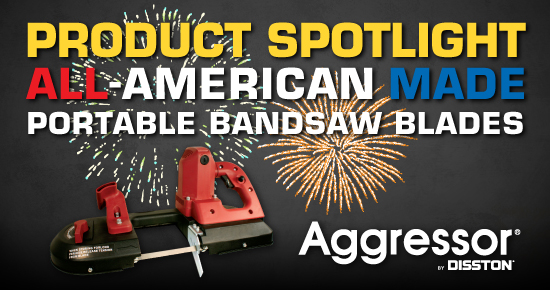Product of the Month
Each month Disston spotlights a different product, including tips on getting the best possible performance. This month:
Aggressor Portable Bandsaw Blades
What is it: Made in the USA, Aggressor Portable Bandsaw Blades offer improved cut quality and shock resistance, are extremely durable and are built to resist tooth strippage. Teeth with uniform spacing and gulleted depth means these blades are perfect for cutting aluminum, brass, copper, cast iron, chrome, stainless steel, tungsten steel and other problem materials. Disston is proud to feature these All-American-Made blades.
Product Details:
– 44-7/8″ length x 1/2″ width x 0.20″ thickness
– 10/14 teeth per inch
– Package of 3 blades
Features:
– Solid carbon steel
– Variable pitch
– Ideal for cutting thickness of 7/32″ to 7/8″
– Best used for cutting problem materials at lower speed
– Bi-metal blades give the greatest blade life and will outperform carbon blades in most cutting applications
– For use only in portable bandsaw machines
Tips for Getting the Best Out of Your Bandsaw:
– It is important to run new bandsaw blades at a reduced rate to break them in. This helps to remove any uneven edges that are imparted on cutting.
– Speed should be determined by the class of material. Portable bandsaws use a trigger switch similar to drills and circular saws, but are usually equipped with a separate speed selector. Saw speed should remain constant.
– Support loose material when cutting. Using a vice to hold the pipe or bar will prevent it from spinning in response to the blade biting into it during a cut. Metal which bends during the cut can bind the blade, causing the operator to lose control of his saw.
– Place the sawblade against the stock to be cut, making sure the blade is parallel to the cut line you have marked, and perpendicular to the stock (if the cut is to be square, or 90 degrees).
– Chips tell you what is happening with your feed pressure and your blade. Powdery or fine chips indicate that not enough feed pressure is being applied. Heavy, thick, or blue burned chips mean you’re pushing the blade too hard, creating too much heat and load for the teeth. Loosely curled chips tell you everything is going well. Adjust your feed until desired chip formation is achieved.
– Do not force the saw or apply excessive pressure, as the saw’s teeth are able to remove only a certain amount of material with each pass. Rocking the saw when cutting very thick, solid pieces of stock may allow the metal chips to clear the saw’s kerf. Holding the saw steady in relation to the cut is the best method.
– Keep the blade lubricated by using a high-quality cutting fluid throughout the cut. The cutting fluid will keep the blade teeth cool while preventing chips from welding to the tooth by lubricating them, allowing them to move through the cut.
– Dress appropriately for bandsaw use. Safety glasses and gloves are important, but also keep in mind that loose jewelry or clothing can easily get caught in the moving blade.
Get the Full Range of Bandsaw Blades
Did you know Disston offers a complete range of bandsaws in various widths, pitches, and tooth configurations for most cutting applications? We have a full offering of bi-metal bands, carbon bands and for highly abrasive materials, we offer our RemGrit carbide grit bands in both continuous and gulleted edges. Check out our full line of Bandsaw Blades HERE.
Happy Fourth of July!
Have big holiday plans or projects? Disston wants to see how you celebrate your 4th. Share your pictures on our Facebook page HERE! Have a safe and happy Independence Day!
Sources include DoItYourself.com
